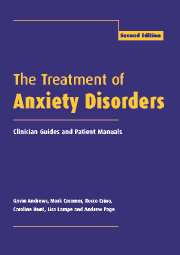Book contents
- Frontmatter
- Contents
- List of authors
- Preface to the second edition
- Abbreviations
- 1 Read me
- 2 General issues in anxiety disorders
- 3 General issues in treatment: Clinician Guide
- 4 Panic disorder and agoraphobia: Syndrome
- 5 Panic disorder and agoraphobia: Treatment
- 6 Panic disorder and agoraphobia: Clinician Guide
- 7 Panic disorder and agoraphobia: Patient Treatment Manual
- 8 Social phobia: Syndrome
- 9 Social phobia: Treatment
- 10 Social phobia: Clinician Guide
- 11 Social phobia: Patient Treatment Manual
- 12 Specific phobias: Syndrome
- 13 Specific phobias: Treatment
- 14 Specific phobias: Clinician Guide
- 15 Specific phobias: Patient Treatment Manual
- 16 Obsessive-compulsive disorder: Syndrome
- 17 Obsessive-compulsive disorder: Treatment
- 18 Obsessive-compulsive disorder: Clinician Guide
- 19 Obsessive-compulsive disorder: Patient Treatment Manual
- 20 Generalized anxiety disorder: Syndrome
- 21 Generalized anxiety disorder: Treatment
- 22 Generalized anxiety disorder: Clinician Guide
- 23 Generalized anxiety disorder: Patient Treatment Manual
- 24 Posttraumatic stress disorder: Syndrome
- 25 Posttraumatic stress disorder: Treatment
- 26 Posttraumatic stress disorder: Clinician Guide
- 27 Posttraumatic stress disorder: Patient Treatment Manual
- 28 Conclusions
- References
- Index
21 - Generalized anxiety disorder: Treatment
Published online by Cambridge University Press: 05 August 2016
- Frontmatter
- Contents
- List of authors
- Preface to the second edition
- Abbreviations
- 1 Read me
- 2 General issues in anxiety disorders
- 3 General issues in treatment: Clinician Guide
- 4 Panic disorder and agoraphobia: Syndrome
- 5 Panic disorder and agoraphobia: Treatment
- 6 Panic disorder and agoraphobia: Clinician Guide
- 7 Panic disorder and agoraphobia: Patient Treatment Manual
- 8 Social phobia: Syndrome
- 9 Social phobia: Treatment
- 10 Social phobia: Clinician Guide
- 11 Social phobia: Patient Treatment Manual
- 12 Specific phobias: Syndrome
- 13 Specific phobias: Treatment
- 14 Specific phobias: Clinician Guide
- 15 Specific phobias: Patient Treatment Manual
- 16 Obsessive-compulsive disorder: Syndrome
- 17 Obsessive-compulsive disorder: Treatment
- 18 Obsessive-compulsive disorder: Clinician Guide
- 19 Obsessive-compulsive disorder: Patient Treatment Manual
- 20 Generalized anxiety disorder: Syndrome
- 21 Generalized anxiety disorder: Treatment
- 22 Generalized anxiety disorder: Clinician Guide
- 23 Generalized anxiety disorder: Patient Treatment Manual
- 24 Posttraumatic stress disorder: Syndrome
- 25 Posttraumatic stress disorder: Treatment
- 26 Posttraumatic stress disorder: Clinician Guide
- 27 Posttraumatic stress disorder: Patient Treatment Manual
- 28 Conclusions
- References
- Index
Summary
The goal of the treatment of GAD is the reduction of impairment that results from both cognitive and somatic symptoms of anxiety: the worry or anxious expectation, and the accompanying symptoms of tension and overarousal. This chapter aims to summarize the evidence for the effectiveness of psychological and pharmacological treatments for GAD.
Psychological treatments
Since the first edition of this book was published, five reviews of the psychological treatment of GAD have been published (Barlow et al., 1998;Borkovec and fihisman, 1996; Fisher and Durham, 1999;Gale and Oakely-Browne, 2000;Gould et al., 1997). All agree that a cognitive behavioral approach is effective for this disorder, a finding that is consistent with previous quantitative and qualitative reviews (e.g., Marks, 1989;Butler and Booth, 1991; Hunt and Singh, 1991; Durham and Allan, 1993). Hence, there is general agreement that cognitive behavioral therapy yields statistically and clinically significant improvement for the majority of patients, and that this change is maintained for up to a year following the end of treatment.
However there is less agreement on the extent to which different therapies produce differential effects. For example, Barlow et al. (1998: 311) stated “Until recently, most studies have not demonstrated differential rates of efficacy for active treatment techniques, although most studies have shown that active treatments are superior to non-directive approaches and uniformly superior to no treatment”. Fisher and Durham (1999) applied Jacobson's criteria for clinical significance to six randomised controlled trials using the State–Trait Anxiety Inventory, Traitffersion (STAI-T) as an outcome measure and showed that both cognitive behavioral therapy and applied relaxation produced recovery rates at 6-month follow-up of 50% to 60%. On the other hand, their results indicated that some individual therapies (behavior therapy and analytical therapy) were ineffective, with recovery rates of 11% and 4%, respectively. Of further interest was the finding that individual therapy produced higher recovery rates than the same treatment delivered in a group format. Fisher and Durham (1999) concluded that while cognitive behavioral therapy may not be the only treatment to deliver reasonable treatment outcome effects, it is unlikely that the effects observed were solely due to spontaneous remission, regression to the mean, or placebo factors.
- Type
- Chapter
- Information
- The Treatment of Anxiety DisordersClinician Guides and Patient Manuals, pp. 398 - 406Publisher: Cambridge University PressPrint publication year: 2002



